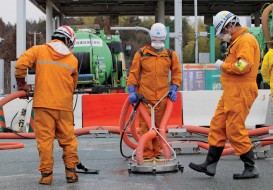Homeless recruited to help clean up Fukushima nuclear plant
Japan addressed worker shortage
In this photo taken Friday, March 1, 2013, workers wearing protective gear conduct a decontamination operation at the entrance of the Joban Expressway in Tomioka, Fukushima prefecture inside the exclusion zone surrounding the tsunami-ravaged Fukushima Dai-ichi nuclear power plant in Japan. Two years after the triple calamities of earthquake, tsunami and nuclear disaster ravaged Japan’s northeastern Pacific coast, radioactive and chemical contamination remains a threat as clean-up projects face troubles with organized crime and mishandling. (AP Photo/Shizuo Kambayashi)
Share

Nearly three years after an earthquake and tsunami ravaged Japan’s northeast coast, the cleanup around the Fukushima nuclear plant is running behind schedule and few people (understandably) are lining up to take on certain jobs around the radioactive wasteland. In response to the worker shortage, Japanese subcontractors are now recruiting the homeless, who are tasked with clearing out debris and soil in the disaster area not far from where three reactors melted down in 2011. In some instances, their paycheques reportedly fall below minimum wage, after deductions for food and accommodation.
There is still plenty of money to be made in the cleanup, which has already cost taxpayers $35 billion. Recruiters earn $100 for every worker they round up, and Reuters, citing arrest records, reports that three big crime syndicates are involved in the process, working under a long, shadowy chain of dozens of subcontractors with little oversight. And there doesn’t appear to be an end to the workload. It could take another three years before residents in the most contaminated areas can return home.